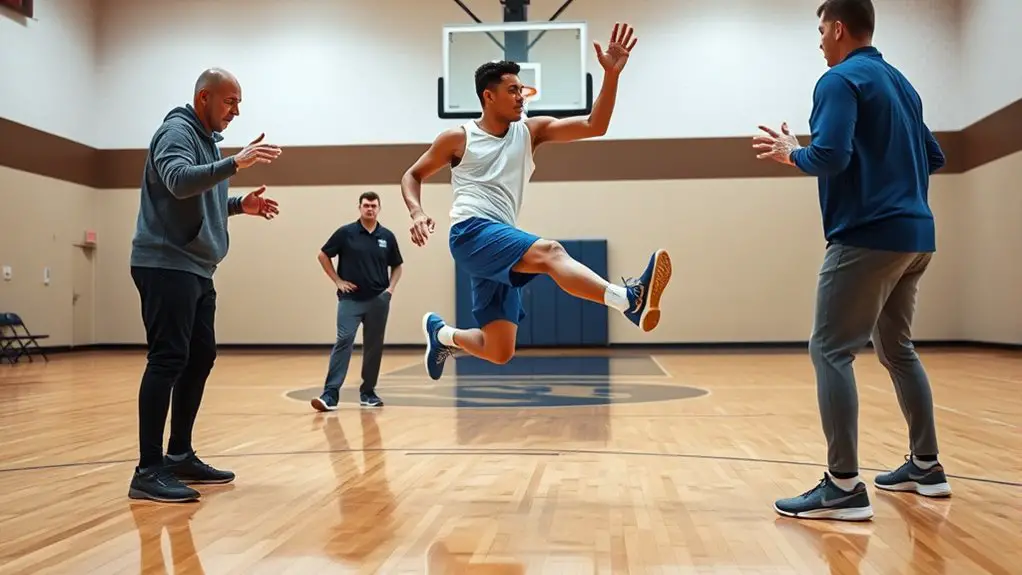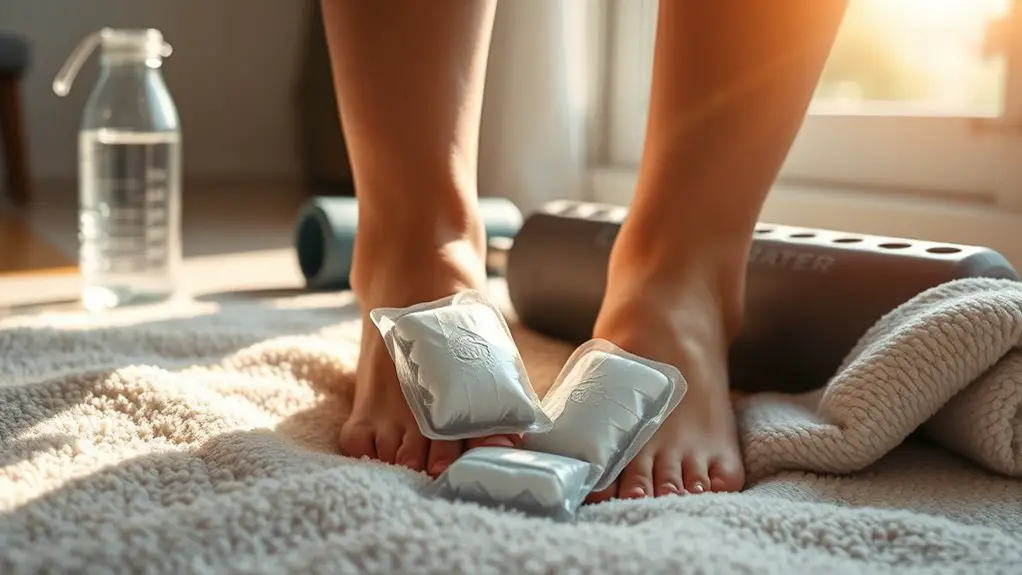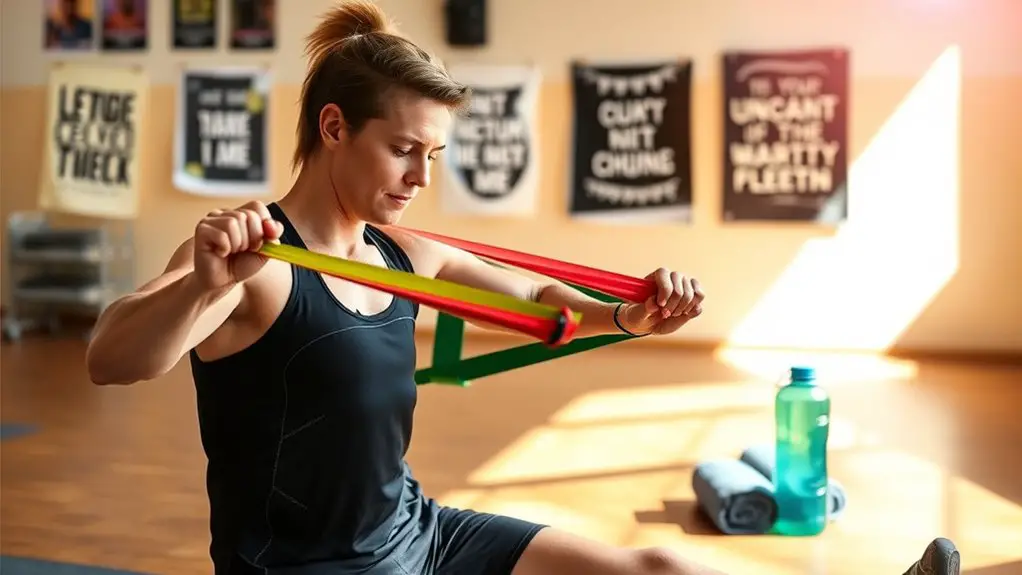To prevent knee injuries in basketball, focus on proper footwear with good cushioning and support. Strengthen your quadriceps, hamstrings, and calves with targeted exercises, and don't skip dynamic warm-ups to prepare your muscles. Pay attention to jumping and landing techniques, ensuring you land softly with bent knees. Also, incorporate balance drills and be mindful of your body – if you feel pain, take it seriously. There's more to discover about knee health and safety in basketball.
Understand Common Knee Injuries in Basketball
When you hit the court, it's vital to understand the common knee injuries that can sideline you. Basketball statistics show that knee injuries are among the most prevalent in the sport, affecting players of all levels. Sprains, tears, and tendonitis can quickly turn your game upside down, making awareness important for your freedom on the court.
The anterior cruciate ligament (ACL) tear is particularly notorious, often occurring during sudden stops or changes in direction. Meniscus tears can also happen, especially if you land awkwardly after a jump. Don't overlook patellar tendonitis, which can develop from repetitive jumping and running. Incorporating strengthening exercises can significantly enhance knee stability and reduce the risk of injury.
Importance of Proper Footwear
Choosing the right footwear is essential for maintaining knee health while playing basketball, as poorly designed shoes can alter your movement and increase the risk of injuries. When you're on the court, you want to feel free and agile, and the right shoes can make all the difference. Look for footwear features like good cushioning and ankle support to absorb impact and provide stability.
A proper shoe fit is vital too—too tight, and you risk blisters; too loose, and you can lose control. Make sure there's enough room for your toes to wiggle while keeping your heel snug. Remember, your shoes are your first line of defense against knee injuries. By investing in quality footwear that suits your play style, you're not just protecting your knees; you're enhancing your game. Additionally, consider your foot type when selecting shoes, as this can significantly affect comfort and injury prevention. So, don't underestimate the power of the right kicks—your body will thank you!
Strengthening Exercises for Knee Stability
To keep your knees healthy on the court, strengthening exercises are essential for stability. You'll want to focus on building knee strength with specific workouts tailored to your needs. It's also important to pay attention to how often you train and how to progress safely over time. Incorporating balance exercises can enhance stability and coordination, further protecting your knees from injury.
Importance of Knee Strength
Knee strength is essential for any basketball player looking to enhance performance and minimize injury risk. When you focus on developing your knee strength, you're not just boosting your power on the court but also improving your knee biomechanics. Stronger knees contribute to better stability, allowing you to make sharp cuts and jumps without compromising your safety. This stability is vital for injury prevention, as weak knees can lead to strains or tears during explosive movements. By prioritizing knee strength, you're giving yourself the freedom to play with confidence and agility. Remember, a solid foundation in your knees will support your overall game, helping you stay on the court longer and enjoy the sport you love without the worry of injuries.
Recommended Strengthening Exercises
Incorporating a variety of strengthening exercises into your routine can greatly enhance knee stability and reduce the risk of injuries on the basketball court. Focus on strength training that targets your quadriceps, hamstrings, and calves. Exercises like squats, lunges, and step-ups can build the muscles around your knee, providing needed support. Don't forget about balance exercises, such as single-leg stands, which improve proprioception and stability. Resistance bands are also fantastic for injury prevention; try lateral band walks to strengthen your hip abductors. Aim for a balanced approach that addresses all muscle groups around your knee. By committing to these exercises, you'll not only boost your performance but also enjoy the freedom of playing with confidence and reduced injury risk.
Frequency and Progression Tips
Consistency is key when it comes to strengthening exercises for knee stability. To effectively build strength and prevent injuries, you'll want to follow some frequency adjustments and progression guidelines. Here are some tips to keep in mind:
- Aim for 2-3 sessions per week for ideal results.
- Gradually increase the intensity of your workouts to avoid burnout.
- Incorporate a mix of exercises targeting different muscle groups.
- Listen to your body; rest if you feel excessive fatigue or pain.
- Track your progress to stay motivated and make necessary adjustments.
Flexibility and Stretching Techniques
When you're on the court, flexibility plays an important role in preventing knee injuries. Incorporating stretching and dynamic flexibility exercises into your routine can enhance your range of motion and support your joints. Proper hydration is also crucial, as it helps maintain joint lubrication and overall performance. Let's explore why these practices are essential for keeping your knees healthy.
Importance of Stretching
Stretching is essential for basketball players, as it enhances flexibility and can greatly reduce the risk of knee injuries. By incorporating both static and dynamic stretching into your routine, you'll prepare your body for the demands of the game. Here are some benefits to keep in mind:
- Increases range of motion
- Reduces muscle stiffness
- Improves blood circulation
- Enhances overall performance
- Lowers injury risk
Static stretching, done after practice, helps lengthen muscles, while dynamic stretching warms them up before you hit the court. Remember, a flexible body is a resilient one, and taking just a few minutes to stretch can make all the difference in keeping your knees healthy and strong. So, don't skip it!
Dynamic Flexibility Exercises
To keep your knees healthy, incorporating dynamic flexibility exercises into your pre-game routine is essential. Dynamic stretching helps warm up your muscles, improving blood flow and preparing your body for action. Instead of static holds, focus on movements like leg swings, walking lunges, and high knees. These exercises not only enhance your flexibility but also increase your range of motion, reducing the risk of injury.
Including a variety of dynamic stretches in your flexibility routine can make a significant difference in your performance on the court. Remember to keep it fun and engaging; this isn't just about injury prevention, it's about feeling free and powerful while you play. So, embrace these exercises and enjoy the freedom they bring to your game!
The Role of Warm-Up and Cool-Down
Although many players might underestimate their importance, a proper warm-up and cool-down routine is essential for preventing knee injuries in basketball. Engaging in dynamic warm-ups prepares your muscles and joints for the intensity of the game, while effective cool-downs help your body recover afterward. Here's what to include in your routines:
A proper warm-up and cool-down routine is crucial for preventing knee injuries in basketball.
- Dynamic stretches like leg swings and high knees to increase blood flow.
- Sport-specific movements, such as dribbling or shooting, to mimic game actions.
- Balance exercises to enhance stability and control.
- Gradual intensity increases in your warm-up to avoid sudden strain.
- Static stretches in your cool-down to improve flexibility and relax muscles. Additionally, incorporating dynamic stretching into your warm-up can energize muscles for an explosive start on the court.
Utilizing Proper Jumping and Landing Techniques
When you jump and land properly, you can greatly reduce the risk of knee injuries during basketball. Understanding jumping biomechanics is essential for both performance and safety. When you take off, aim for a balanced stance that engages your core and legs. This helps distribute forces evenly as you leave the ground.
As you land, your landing posture is key. Bend your knees and hips, keeping them aligned with your feet. Avoid locking your knees, which can lead to injury. Instead, absorb the impact by lowering your center of gravity, allowing your body to naturally spring back into motion. Incorporating proper warm-ups into your routine can further enhance your body's resilience and readiness.
Practicing these techniques consistently can make a world of difference. You'll not only enhance your game but also protect those critical knees. Embrace the freedom of movement on the court, knowing you've got the skills to keep your body safe while enjoying the sport you love.
Incorporating Balance and Agility Drills
Incorporating balance and agility drills into your training routine can greatly enhance your performance on the basketball court while reducing the risk of knee injuries. These drills help build strength, coordination, and stability, allowing you to move more efficiently. Here are some effective exercises to include:
- Single-leg stands: Improve your balance by standing on one leg for a set time.
- Lateral hops: Jump side to side to boost agility and strengthen your knees.
- Cone drills: Set up cones and practice quick changes in direction.
- Balance board exercises: Use a balance board to challenge your stability and core strength.
- Box jumps: Perform controlled jumps onto a sturdy box to enhance explosive power.
Incorporating these exercises into your routine not only supports enhanced agility but also helps in dodging opponents and navigating obstacles effectively.
Listening to Your Body: Recognizing Warning Signs
How can you tell if your body is signaling distress during training? It's vital to tune in to those pain signals and fatigue indicators that pop up while you're pushing your limits on the court. Maybe you're feeling a sharp ache in your knee or a persistent soreness that doesn't fade. These are your body's way of saying, "Hey, slow down!" Ignoring these signals can lead to serious injuries that sideline you for longer than you'd like.
When fatigue sets in, don't brush it off as a sign of weakness. Instead, recognize it as a warning to rest and recover. Listening to your body enhances proper warm-up techniques to prepare your muscles for the demands of the game. Listen closely to how your body feels during and after practice. If something feels off, it's a sign to adjust your training or take a break. Remember, maintaining your freedom on the court means respecting your body's limits and prioritizing your health.
Consulting Professionals: When to Seek Help
If you've been experiencing persistent pain or discomfort in your knees, it's vital to consult a professional sooner rather than later. Ignoring these issues can lead to more severe injuries down the line. Here's when you should consider seeking help from knee specialists for injury assessments:
- You feel sharp pain during activities.
- Swelling or inflammation persists after games.
- You experience instability or weakness in your knee.
- Pain interferes with your daily activities or workouts.
- You notice a decrease in your range of motion.
A knee specialist can provide a thorough assessment, recommend appropriate treatments, and help you develop a tailored recovery plan. Remember, staying proactive about your knee health is essential to enjoying the freedom of playing basketball. Don't hesitate to reach out for support; your knees will thank you in the long run!
Frequently Asked Questions
Can Knee Injuries Affect My Performance on the Court?
Absolutely, knee injuries can seriously impact your performance on the court. When you're dealing with pain or limited mobility, it's tough to give your best effort. You might find your agility, speed, and endurance all suffer. To maintain that freedom to play your game, focusing on injury prevention is key. Strengthening your knees and ensuring proper technique can help keep you in top form and minimize those risks that threaten your performance.
How Do Age and Experience Influence Knee Injury Risk?
Age factors and experience impact your risk of knee injuries considerably. As you get older, your joints can become less resilient, making you more susceptible to injuries. Meanwhile, experience can help you understand your body's limits and improve your technique, reducing the chance of mishaps. It's crucial to stay aware of these influences, so you can adapt your training and play safely. Enjoy the freedom of the game while being mindful of your body's needs.
What Role Does Nutrition Play in Knee Health?
Nutrition plays an essential role in maintaining knee health. You need to focus on a balanced diet rich in anti-inflammatory foods. Dietary supplements like omega-3 fatty acids can support joint function. Don't forget hydration strategies, as staying well-hydrated helps maintain synovial fluid, which cushions your joints. By prioritizing these aspects of your nutrition, you can keep your knees strong and flexible, giving you the freedom to move without worry.
Are There Specific Knee Braces Recommended for Basketball Players?
When it comes to knee braces, think of them as your trusty shield against injury. There are several knee brace types, like sleeves, wraparounds, and hinged braces, each designed for injury prevention. Depending on your needs, a lightweight sleeve might offer support without restricting movement, while a hinged brace could provide extra stability for high-impact play. Choosing the right brace can help you feel free and confident on the court, ready to conquer your game.
Can I Return to Play Immediately After a Knee Injury?
You might be enthusiastic to jump back into play after a knee injury, but it's essential to take into account the rehabilitation timeline and get a thorough injury assessment first. Rushing back could lead to more damage and longer recovery. Listen to your body—if you're still feeling pain or instability, wait. Your freedom on the court will be worth the patience, allowing you to play at your best without the fear of reinjury.




